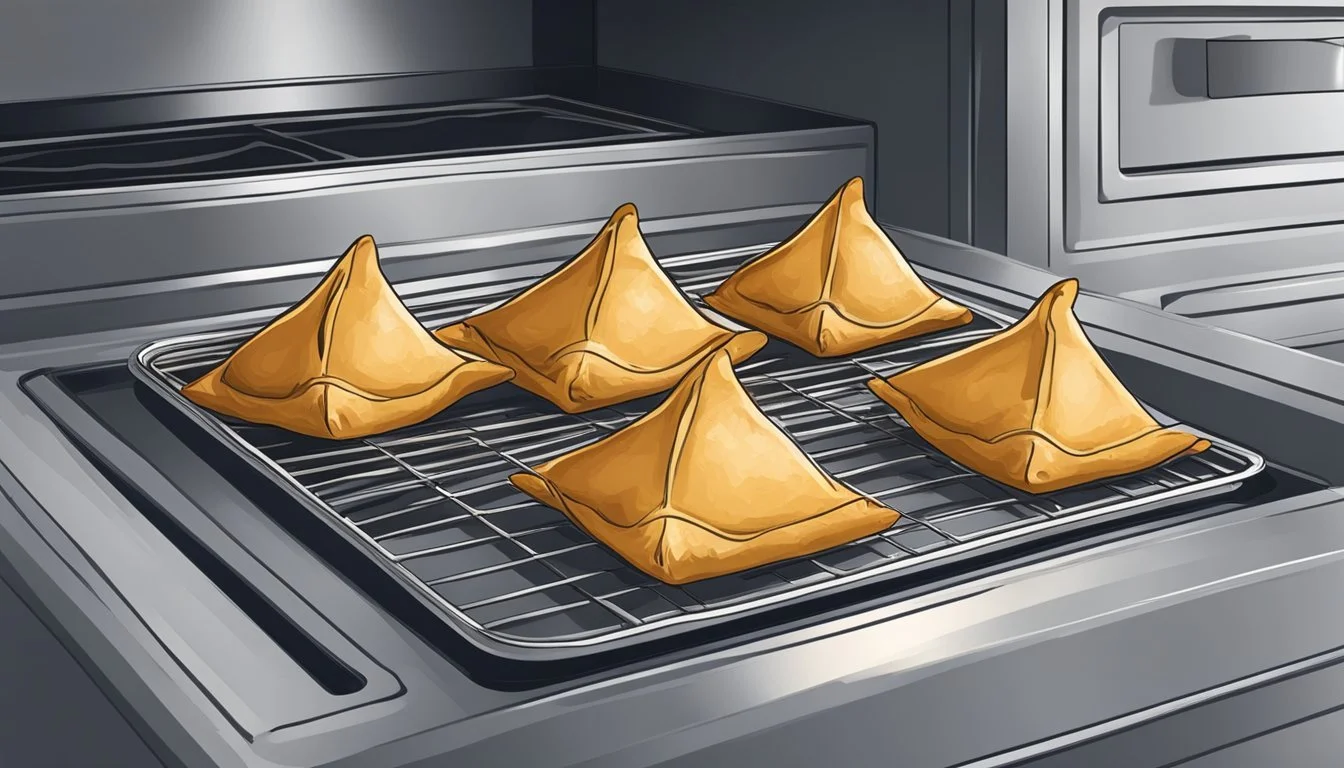Best Way to Reheat Samosa
Ensuring Crispiness and Flavorful Filling
Samosas, with their golden, crispy pastry and richly spiced filling, are a beloved snack across the globe. Preserving the texture and taste of this delicacy when reheating is paramount for enjoying them as if they've just been made. Many samosa aficionados face the challenge of reheating them without losing their defining crunch and the warm, aromatic flavors of the filling.
The key to a perfectly reheated samosa is using the right technique that maintains its crispy exterior while ensuring the filling is heated through. Using an oven to reheat samosas is widely recognized as the best approach to achieve this balance. This method evenly warms the samosa and revives the flakiness of the pastry, while the filling regains its savory allure without becoming soggy.
While alternative reheating methods such as microwaves, skillets, or air fryers are available, they often fall short in providing the desired outcome. Microwaves, for instance, tend to make the pastry soft, and skillets may require additional oil, leading to a less than ideal texture. Understanding the intricacies of these methods allows for an appreciation of why oven reheating is superior and how it upholds the integrity of the samosa's beloved texture and taste.
Understanding Samosas
Samosas are a beloved snack with a rich history and a diversity of flavors, tailored by a vast array of fillings that transform simple pastries into cultural staples.
History and Cultural Significance
Samosas originated in the Middle East and Central Asia, later becoming popular in South Asia, Southeast Asia, the Mediterranean, and Africa. Initially called 'samsa' after the pyramids in Central Asia, they entered Indian cuisine between the 13th and 14th centuries via traders. The popularity of samosas is due to their versatility and the fact that they can be eaten at any time, making them a staple in many cultures.
Typical Ingredients and Fillings
The classic samosa filling is a savory medley of mashed potato, peas, and spices, such as cumin and coriander. However, fillings vary widely to include:
Meat: Mince (lamb, beef, or chicken)
Vegetables: Potatoes, peas, onions, carrots, and lentils
Spices: Ginger, garlic, chilies, garam masala, turmeric, and more.
This pastry is typically triangular, made from maida or all-purpose flour, and deep-fried to golden perfection, offering a delicious balance between the crispy outer shell and the hearty, flavorful filling.
Storing Samosas Properly
Proper storage is key to maintaining the freshness and flavor of samosas, ensuring they are just as enjoyable when reheated. Whether keeping them in the fridge or freezer, certain techniques will help preserve their quality.
Best Practices for Fresh Samosas
For fresh samosas that will be consumed within a few days, they should be stored in an airtight container in the refrigerator. To prevent any moisture from making the samosas soggy, line the container with paper towels, which will absorb excess moisture. Here are clear steps to store them:
Allow the samosas to cool to room temperature to avoid condensation.
Place a layer of paper towels at the bottom of the container.
Arrange the samosas in a single layer, making sure they don't touch each other to maintain their crispy exterior.
Seal the container with its matching lid or with a tight layer of plastic wrap.
Freezing and Thawing Techniques
To extend the shelf life of leftover samosas, freezing is an excellent method. When freezing samosas:
Wrap each samosa individually in plastic wrap to avoid freezer burn.
Place the wrapped samosas into a zip-lock freezer bag or an airtight container before placing them in the freezer.
Label the container with the date to keep track of the freezing time.
To thaw frozen samosas, transfer them from the freezer to the fridge and allow them to thaw slowly, usually taking a few hours. Thawing them gradually in the fridge will help maintain their texture and reduce the chances of the pastry becoming soggy. Avoid thawing samosas at room temperature, as the differential thawing of the filling and pastry can compromise their quality.
Reheating Fundamentals
Reheating samosas properly is paramount to preserving their crispy pastry and flavorful filling. This section focuses on ensuring that the reheating process brings out the best in your samosas.
Preparation for Reheating
Before one initiates the reheating process, it is essential to bring the samosas to room temperature. Removing them from the refrigerator 15-30 minutes prior serves this purpose, achieving more uniform heating.
For Oven Reheating:
Step 1: Preheat the oven to 350°F (180°C).
Step 2: Arrange the samosas on a wire rack placed over a baking sheet covered with foil or parchment paper to avoid sticking and for easy cleanup.
For Stovetop Reheating:
Step 1: Heat a non-stick pan, skillet, or tawa on medium.
Step 2: Lightly oil the surface if desired.
Choosing the Right Reheating Method
Oven Method:
Duration: Heat uncovered for 7-10 minutes.
Consistency: Results in evenly heated and crisp samosas.
Microwave Method:
Duration: Generally not recommended, but if necessary, use short bursts of 10 seconds to prevent sogginess.
Consistency: May result in a less crisp outcome, so finish in a hot oven or on the stove if needed.
Stovetop Method (Non-stick pan or Skillet):
Duration: Few minutes per side until the exterior is crisp to the touch.
Consistency: Offers control over crispiness, but requires attention to prevent burning.
Oven Reheating Technique
The oven reheating technique is favored for its ability to revitalize samosas to golden brown perfection with a crispy exterior. This method ensures that both pastry and filling are heated evenly without compromising texture.
Step-by-Step Oven Instructions
Preheat the oven to 350°F (180°C), an optimal temperature to achieve crispiness without burning.
Place the samosas onto a wire rack set over a baking tray or baking sheet; this arrangement allows air to circulate freely, preventing sogginess.
If the samosas have been refrigerated, let them sit at room temperature for a few minutes before placing them in the oven. For frozen samosas, tack on additional time as needed.
Avoid overcrowding the tray to ensure each samosa reheats uniformly.
Heat the samosas for approximately 7-10 minutes. Larger samosas might require a few extra minutes to ensure the filling becomes thoroughly warm.
Achieving Crispy Texture in the Oven
Crispy Texture: For samosas to regain their characteristic crispy texture, the oven should be fully preheated before reheating begins.
Wire Rack: Using a wire rack as opposed to placing samosas directly on a baking sheet encourages a crispy coating on all sides.
Monitor the samosas while they reheat and look for a crispy pastry that is a light golden brown; this is a sign they are done.
To avoid a chewy or firm exterior, one should not exceed the recommended heating time.
Stovetop Reheating Approach
The stovetop reheating method offers the advantage of precise heat control and the potential for a crisp exterior. For optimal results, one should use the right cookware and oil, pay attention to temperature, and handle the samosas carefully.
Using a Skillet or Tawa
For reheating samosas on the stovetop, a skillet or a tawa (a flat or slightly concave disc-shaped frying pan) is recommended. Non-stick pans work well for this purpose to prevent sticking and tearing of the pastry. Here are the steps:
Preheat the skillet or tawa on medium heat.
Add a small amount of vegetable oil—just enough to lightly coat the bottom of the pan.
Gently place the samosas on the skillet and let them heat slowly.
Turn the samosas often using tongs to ensure even browning and heating on all sides.
The key is to allow the heat to penetrate the samosa, reheating the filling without burning the pastry.
Tips for Stovetop Reheating
For samosas that are deeply frozen, one can first wrap them in foil and let them thaw a bit on the skillet before removing the foil to crisp up the pastry.
Control the heat to avoid scorching. If the heat is too high, the samosas may become too crispy on the outside while still being cold on the inside.
If you're reheating already deep fried samosas, be extra cautious with the amount of oil you use since they'll already contain residual oil from the first fry.
For frying or deep frying in a vessel, regulate the temperature to ensure the oil is not too hot, as this will cook the outside too quickly and may leave the inside cold.
Oil should be heated properly before introducing the samosa to prevent absorption and sogginess. However, stovetop reheating is not recommended for deep frying as it is less efficient than using a dedicated deep frying vessel.
Microwave Reheating Option
The microwave offers a quick heating method that must be managed carefully to maintain the samosa's crispy pastry and flavorful filling without inducing sogginess.
How to Use the Microwave Safely
To safely reheat samosas in a microwave, one should always use a microwave-safe plate or dish. Here's the step-by-step process:
Test dish safety: Ensure the plate or dish is labeled microwave safe.
Microwave setup: Ensure the microwave is clean to avoid any cross-contamination or odd smells transferring to the samosa.
Preventing Sogginess in the Microwave
Maintaining a crispy texture when microwaving samosas requires specific steps:
Prep your samosas: Arrange the samosas on a microwave-safe dish in a single layer to allow for even heating.
Paper towel technique: A damp paper towel can be placed over the samosas to prevent them from drying out, while absorbing excess moisture to reduce sogginess.
Microwave in bursts: Heat the samosas in 30-second intervals, checking the temperature and texture between each interval to avoid overheating.
Manage condensation: After heating, let the samosas sit for a short period in the microwave. This allows for the escape of any built-up steam and reduces condensation, which can make the pastry soggy.
Alternative Reheating Methods
While traditional oven reheating is common, alternative methods can offer convenience and add unique qualities to the reheating process.
Air Fryer Reheating Tips
Using an air fryer can revive the crispness of samosa pastry effectively. It's important to preheat the air fryer to 350°F (180°C). Once heated, place the samosas in the air fryer basket, ensuring they are not overcrowded, to allow even circulation of hot air. Heat the samosas for approximately 3-4 minutes. Monitor closely as air fryers can vary in intensity.
Utilizing the Broiler for Reheating
The broiler can be used for reheating samosas by imparting a slight char and crispness. First, one should preheat the broiler. Place the samosas on a broiler-safe pan, and position them under the broiler for 1-2 minutes on each side. Watch them carefully, as the high heat can brown the pastry quickly.
Grill and Barbecue Options
Grilling or barbecuing samosas can introduce a smoky flavor that enhances their taste profile. When using a grill or barbecue, one must use the grill function carefully. Set the grill to a medium heat and place samosas directly on the grate for 2-3 minutes per side. This technique requires vigilance to prevent charring.
Final Touches and Presentation
After carefully reheating samosas, achieving a crispy pastry and a moist, flavorful filling, it is important to present them properly for the ultimate experience.
Ensuring Even Heat Distribution
Once the samosas are properly reheated, one should ensure they are evenly heated through to the center before serving. Samosas that have been heated in the oven or air fryer must be checked by inserting a fork gently in the middle to confirm they are hot throughout. This step is crucial for the filling to impart its full flavor and for maintaining the desired crispy texture of the outer pastry.
Serving Suggestions
Presentation enhances the overall enjoyment of the samosas. Serve them on a warm plate to maintain their temperature. Provide a selection of dipping sauces on the side; popular choices include tamarind chutney, coriander mint chutney, or even a spiced yogurt sauce. Each sauce can accentuate the samosa's flavorful filling and add moisture to each bite.
Tamarind Chutney: sweet and tangy, perfect for complementing the spices within the samosa.
Coriander Mint Chutney: offers a fresh, herby flavor that cuts through the richness of the filling.
Spiced Yogurt Sauce: cools down the palate and enhances the samosa's spices without overwhelming them.
Ensure these sauces are served in separate bowls for guests to choose according to their preference, creating a customized and delicious-tasting filling experience.
Conclusion
Reheating samosas effectively preserves their desirable crunchy texture and flavorful filling. The consensus among culinary experts is that an oven provides the superior method for warming these pastries.
Ideal Oven Method:
Temperature: Preheat to 350°F (180°C).
Placement: Arrange samosas on a wire rack or lined baking sheet.
Duration: Heat for 7-10 minutes until they are warmed through.
Microwave usage is not recommended due to its tendency to render the pastry soggy. If a microwave is the only option, a short ten-second burst may be used to warm the filling before transferring to an oven.
Lastly, samosas should attain a golden brown color, indicative of a properly reheated pastry. This ensures that the exterior remains crisp, thereby keeping the taste and texture as enjoyable as originally intended.




